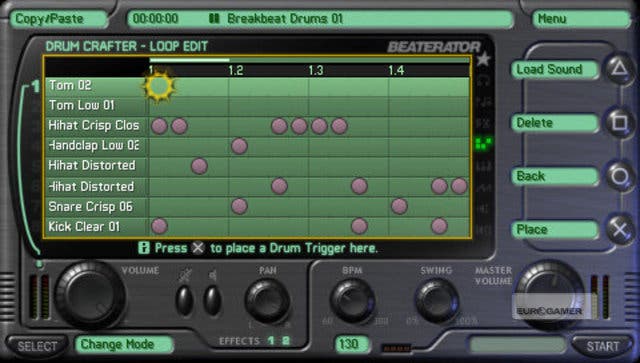Beaterator
Grand Theft Audio.
Beaterator, as a piece of serious music software masquerading as a videogame, is not without precedent. In 1999, Codemasters' Music introduced a generation of PlayStation gamers to the world of digital music sequencing and, apocryphally at least, was in part responsible for launching the careers of Dizzee Rascal and The Streets. Beaterator, like Music before it, approximates the form and function of professional mixer packages such as Propellerheads' Reason, Apple's Logic and even ProTools, supplying a bevy of Timbaland-endorsed loops alongside the tools to write and even record your own music. The result is an extraordinary piece of diminutive compositional software, one that's primarily limited by user imagination and perseverance in mastering its somewhat labyrinthine menus and options.
For musicians familiar with the Nintendo DS' Korg DS 10 package, Beaterator offers a significant upgrade in terms of features and raw potential, despite its somewhat cartoonish frontend. At its core sits an 8-track sequencer allowing up to eight audio channels to be filled with loops of music and then played back simultaneously to create a song. The 'Song Crafter' interface will be familiar to anyone who's dabbled with digital music-creating software. Time's represented on the X-axis, divided into bars and subdivided into 16th beats. On the Y-axis you'll find eight rows, each of which can be assigned to a different instrument. By adding loops to these channels you build up your song, adding texture and form layer by layer.
To begin with, the simplest way into Beaterator composition is to pluck ready-made loops from its library of thousands of premade samples. You can search this brimming database by genre or by instrument and, generally, unless otherwise marked, everything is written in the same key as everything else in order to loosely fit together. So, on the first channel you might cue up a drum and bass drum pattern, before adding a dub-style bass on the second channel, a classical guitar on third and so on. All of the loops match to the .bpm of the song template (which can be easily changed at any time) and so, in next to no time, even beginners can have a rhythm and melody up and running.

Of course, while the stock loops are great for finding inspiration, if you want to start making unique creations you'll need to get stuck in writing your own loops and patterns. This is done via a standard Midi editor tool, which for melodic instruments presents you with a few octaves of a keyboard and then allows you to write in notes by hand along a rudimentary stave, right down to 16ths of a bar. Here you can set the length of each individual note and its associated volume and thus begin to write your own melodies. Once you're happy with your melodic 'loop' you then drop it into the mixer as you would any premade loop.
Samples in the library can all be individually tweaked, adding reverb, phase, and delay effects and you can even go into a waveform editor to, say, reverse a drum loop for style. Of course, you're fundamentally limited to just 8-tracks of simultaneous audio, so compositions can never become too complicated or layered, but as a pocket sketchpad for ideas, or even a tool for learning the basics of production and music composition, Beaterator is peerless on console platforms. Indeed, almost all of the lessons you'll learn in piecing together music are directly transferable to the aforementioned desktop programs, so would-be producers can be sure that they won't pick up any bad or superfluous habits.


